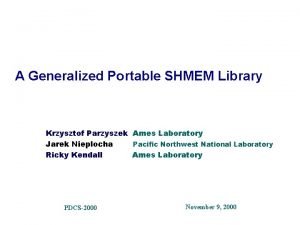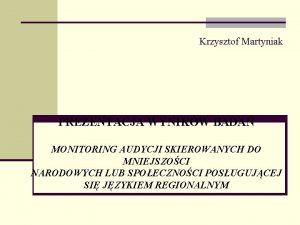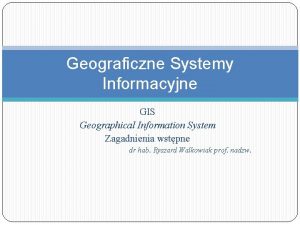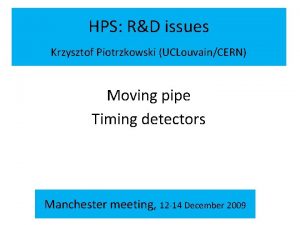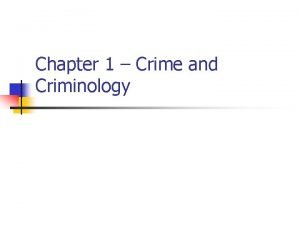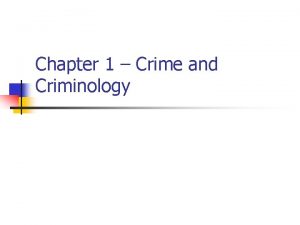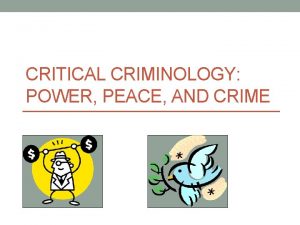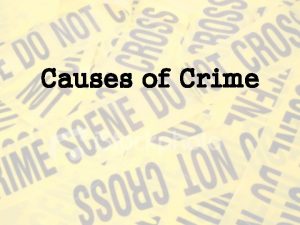Krzysztof Krajewski Jagiellonian University Department of Criminology Krakow





















- Slides: 21

Krzysztof Krajewski Jagiellonian University Department of Criminology Krakow - Poland Gaps in the knowledge base – evidence in the criminal justice system and its implementation in practice Conference Identifying Europe’s information needs for effective drug policy Lisbon, 6 – 8 May, 2009

Basic question To evaluate drug policies in any country, it is important to have information on three aspects of these policies: 1) to what extent criminal law and criminal justice interventions are directed towards supply of drugs and to what extent towards demand for drugs; 2) to what extent criminal law and criminal justice interventions regarding demand constitute either purely repressive interventions, or involve also alternative measures intended to divert offending drug users to the treatment system; 3) what are the reasons for eventual different patterns; 2

Indexed trends in reports for drug-related offences by broad type of offence in the EU Member States 2002– 07 Source: EMCDDA Statistical Bulletin 2009, Figure DLO-1 3

Offences type in reports for drug law offences in Europe Source: EMCDDA Statistical Bulletin 2009, Figure DLO-2 4

Proportion of cannabis related offences in reports for drug law offences Source: EMCDDA Statistical Bulletin 2009, Table DLO-3 5

Indexed trends in reports for drug law offences by type of drug in the EU Member States 2002– 07 Source: EMCDDA Statistical Bulletin 2009, Figure DLO-3 6

Indexed trends in reports for drug law offences related to drug use or possession for use in the EU Member States 2002– 07 Source: EMCDDA Statistical Bulletin 2009, Figure DLO-4 7

Selection mechanisms in the criminal justice system: „funnel model” Input: number of really committed offences Output: number of reported (registered) offences Output: number of prosecutions Output: number of convictions Output: number of people serving prison term 8

Tasks for the future • it may be worth effort to learn more about and to attempt to explain significant differences in outcomes of the selection mechanism and criminal justice interventions between European countries; • however, this may be difficult without certain data being available throughout Europe on the national level; • targeted data collection and specific research projects may be necessary here; 9

Drug offences rates in European countries (2007) Rates per 100 th. inhabitants Source: EMCDDA Statistical Bulletin 2009, author’s own calculations 10

Drug use related offences rates in European countries (2007) Rates per 100 th. inhabitants Source: EMCDDA Statistical Bulletin 2009, author’s own calculations 11

Drug supply related offences rates in European countries (2007) Rates per 100 th. inhabitants Source: EMCDDA Statistical Bulletin 2009, author’s own calculations 12

Drug offences rates in European countries (2007) - ranking according to the overall rate Rates per 100 th. inhabitants Source: EMCDDA Statistical Bulletin 2009, author’s own calculations 13

Drug offences rates in European countries (2007) - ranking according to the use related offences rate Rates per 100 th. inhabitants Source: EMCDDA Statistical Bulletin 2009, author’s own calculations 14

Drug offences rates in European countries (2007) - ranking according to the supply related offences rates Rates per 100 th. inhabitants Source: EMCDDA Statistical Bulletin 2009, author’s own calculations 15

Preliminary conclusions • law enforcement effort in most countries seems to concentrate on the use related offences; • this is especially visible in some countries ranked quite low on supply related offences, but being champions in use related offences rates, and because of this also champions in general drug offences rates; • more precise knowledge is highly desirable about reasons for this pattern; • this may be of great importance for evaluating impact of the law enforcement effort on various aspects of the drug problem; 16

Drug offences rates and conviction rates for drug offences in European countries (2003) Rates per 100 th. inhabitants Source: European Sourcebook of Crime and Criminal Justice Statistics, Third Edition 17

Drug offences rates and convictions rates for drug trafficking offences in European countries (2003) Rates per 100 th. inhabitants Source: European Sourcebook of Crime and Criminal Justice Statistics, Third Edition 18

Preliminary conclusions • attrition rate (difference between registered offences rate and convictions rate) seems to be huge in case of some countries; • this suggests that many registered drug offences are never prosecuted, and it never comes to conviction for them; • as this rate seems to be generally lower in case of supply related offences, it may mean that use related cases are mostly responsible for that phenomenon; • it is highly desirable to know why is it so: are these cases just dropped off for some reasons, or are they diverted to be dealt with in other way? 19

Conclusion • gaps in the knowledge about criminal justice interventions in case of drug offences seem to be quite substantial throughout Europe; • because of this the need to collect more data and to conduct research in this area seems to be especially acute! 20

Thank you for your attention!
 Prof. mirosław krajewski
Prof. mirosław krajewski Prof. wojciech krajewski
Prof. wojciech krajewski Andy krajewski
Andy krajewski Dr claire hamilton
Dr claire hamilton Ccjp guelph
Ccjp guelph University of bath criminology
University of bath criminology Krzysztof fiok
Krzysztof fiok Krzysztof flizak
Krzysztof flizak Krzysztof parzyszek
Krzysztof parzyszek Krzysztof sierański
Krzysztof sierański Krzysztof parzyszek
Krzysztof parzyszek Krzysztof zajda
Krzysztof zajda Chciał zostać poetą a wynalazł dynamit
Chciał zostać poetą a wynalazł dynamit Tvp opole
Tvp opole Mrongowiusz
Mrongowiusz Krzysztof bielecki chirurg
Krzysztof bielecki chirurg Wykres giełda
Wykres giełda Krzysztof paczka
Krzysztof paczka Krzysztof juszczyszyn
Krzysztof juszczyszyn środki komunikacji elektronicznej
środki komunikacji elektronicznej Krzysztof dobosz umk
Krzysztof dobosz umk Krzysztof piotrzkowski
Krzysztof piotrzkowski








